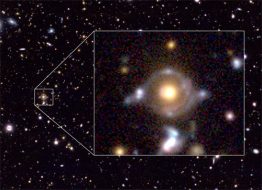Students Discover a Galactic Eye of Horus
Undergraduate students in Japan stumbled on a rare lensing of two distinct background galaxies.

Eye of Horus in pseudo color. Enlarged image to the right. The yellow object at the center is a galaxy about 7 billion light-years away and bends the light from two background galaxies.
NAOJ
NAOJ
I don’t know about you, but I’ve always secretly wanted to serendipitously discover something incredible in one of my lab courses. Well, some students in Japan got to experience just that. A group of astronomers and undergraduate students at the National Astronomical Observatory of Japan (NAOJ) in Tokyo found a unique galaxy system they dubbed the Eye of Horus.
Masayuki Tanaka (NAOJ) and several students were looking at images taken with the Hyper Suprime-Cam at the Subaru telescope when they found the odd-looking system.
Once Tanaka saw the warped light, he immediately recognized it as a strong gravitational lens — where a galaxy's gravity bends the light from a background galaxy. Strong lensing helps probe the distribution of matter around galaxies.
A closer look at the images showed one reddish ring and another with a blue tint. The two colors suggested that not just one but two galaxies were being lensed, something that’s rarely observed. There are only a handful of systems like this currently known, but the distant galaxies haven’t been measured because they’re too faint.
Based on data from the Sloan Digital Sky Survey, light from the lensing galaxy takes 7 billion years to arrive at Earth. Astronomers conducted follow-up observations on the Magellan Telescope and confirmed that light from the background galaxies take 9 and 10.5 billion years, respectively. The data confirm that there are two galaxies at two different distances. They also show that one of the galaxies seems to be made of two distinct clumps, according to Kenneth Wong (NAOJ), which could indicate a pair of interacting galaxies.
With 300 nights of data, the Hyper-Suprime Cam's survey is the largest observing program ever approved at the Subaru Telescope. The survey, still in its early phases, hopes to address outstanding astrophysics questions about the nature of dark energy, how galaxies evolve, and when galaxies first started pumping out stars. The team expects to find about 10 more double-lensed galaxies in the survey.
No comments:
Post a Comment